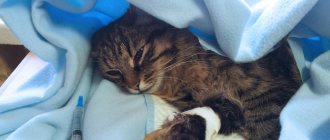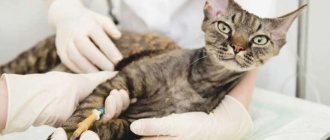Description
With pyelonephritis, small foci of inflammation appear in the kidneys, this leads to the disintegration of the renal papillae and softening of the cortex. Bacteria invade the capillary network of the glomeruli, causing unpredictable pathological processes.
This happens:
- partial damage to parenchymal tissue;
- purulent softening of the organ;
- kidney shrinkage.
After the disease spreads to the entire parenchyma, renal epithelium and casts appear in the urine.
The course of the disease is:
- acute – the inflammatory process lasts 2 weeks and immediately affects the kidneys, bladder, and ureters;
- chronic – a sluggish, purulent inflammatory process that leads to renal failure and kidney abnormalities;
- recurrent - recurring periodically.
Chronic pyelonephritis can be hidden, wavy, and manifests itself as a constant general malaise.
Form of the disease:
- primary – the infection immediately affects the kidneys;
- secondary – develops against the background of concomitant infectious diseases.
Bilateral pyelonephritis affects both kidneys, unilateral – one, purulent, hemorrhagic or catarrhal.
With frequently recurring pyelonephritis, the cat’s depuration function fades, nephrotic sclerosis develops, which leads to the death of the pet.
What does successful treatment of pyelonephritis in a cat consist of?
Treatment for pyelonephritis consists of a variety of antibiotics, surgery may be indicated, and if the pet’s condition does not allow such a complex intervention, as well as symptomatic treatment, for example, analgesic, antipyretic medication. Of course, with such an abundance of medications, the animal’s intestines and liver will suffer. It is for this reason that the doctor will prescribe restorative and supportive medications that can provide invaluable support.
Causes
Viral leukemia
Distemper in cats
Microsporia
The disease does not have a specific pathogen. The main reason is bacteria that enter the genitourinary system. In the last century, scientists believed that the causative agents of pyelonephritis were enterococci, staphylococci, fungi, and viruses.
Recent developments by scientists refute these facts. Research shows that pyelonephritis is caused by E. coli in its various manifestations.
The main thing is to determine which type of E. coli caused the disease.
Circumstances that contribute to the formation of conditions for the appearance of pathologies in the renal pelvis:
- urolithiasis disease;
- mechanical irritation of the genitourinary tract;
- purulent processes on internal organs;
- disturbance of urine outflow;
- hypothermia;
- decreased immunity;
- increased concentration of drugs, toxic, chemical, radiation substances in the kidneys.
Pyelonephritis in a cat can be caused by an unbalanced, unhealthy diet, when the animal’s diet contains a large amount of protein, salt, and fat.
Symptoms
An insidious disease in the initial stages is not always immediately noticeable. The chronic course of pyelonephritis does not manifest itself externally; it can only be determined by the results of laboratory tests.
Acute pyelonephritis in cats gives the following symptoms:
- fever, chills, slight trembling;
- indifference to external stimuli, depressed state;
- fast fatiguability;
- frequent, painful urination, with blood;
- anorexia.
In the acute course of the disease, the pet develops renal colic and abdominal pain. The animal meows pitifully not only during urination, but also without it.
If pyelonephritis occurs in a purulent form, the genitourinary system is destroyed - uremia, renal failure occurs with the following symptoms:
- lack of appetite;
- elevated temperature;
- nausea, vomiting with bile;
- viscous, cloudy urine;
- constant desire to drink water;
- apathy towards what is happening.
The cat's gait becomes unnatural and constrained. When walking, the legs tremble, bend, the back is arched.
If any of these signs appear, you should immediately contact a veterinarian. The doctor will make the correct diagnosis and immediately prescribe treatment.
Pyelonephritis in cats occurs more often in older individuals.
Kidney disease in a pet
Pyelonephritis in a cat is a serious disease caused by a bacterial infection and requires the intervention of a veterinarian. The first to suffer from this disease is the renal pelvis. If you do not resort to treatment in time, the disease will “spread” to the blood vessels and glomeruli. It is important to identify symptoms and prescribe appropriate treatment.
It is strictly not recommended to treat the animal yourself. This disease must be treated by a qualified physician. Otherwise, curing this disease with home and folk remedies is fraught with the death of your pet.
So what is pyelonephritis, what are its signs and what actions to take to save the health and life of your pet?
Description of the disease
There are several types of pyelonephritis in cats.
By type:
- catarrhal;
- hemorrhagic;
- purulent.
By type of origin:
- primary origin;
- secondary origin.
This disease in cats of primary origin begins directly in the organs of the excretory system - the kidneys. In secondary cases, inflammation begins in the urinary tract and bladder and rises higher. In this case, the precursors of such a disease can be called functional or organic damage to organs.
The causes of a disease such as pyelonephritis in cats include:
- the appearance of sand and kidney stones (mechanical irritation of the renal pelvis);
- the development of a bacterial infection, the pathogens of which affect the organs of the animal’s excretory system;
- functional disruption of the genitourinary system of animals, which results in stagnation of urine;
- attack of the kidneys by opportunistic organisms (staphylococci, E. coli, streptococci, etc.);
- ingestion of various poisons into the pet’s body that irritate the animal’s genitourinary system;
- decomposition of urine inside the organ due to a number of reasons.
When making a diagnosis, the veterinarian prescribes appropriate medications that can save the animal from a serious illness. The owner only needs to detect pyelonephritis in the cat, the symptoms of which will be described below, and immediate treatment by a qualified doctor will “put the pet back on its feet.”
Symptoms of the disease
If the symptoms of pyelonephritis in cats are not detected in a timely manner, the disease can develop into a chronic one. And this is already fraught with other consequences.
So, the following signs are characteristic of acute pyelonephritis in cats:
- fever that begins and lasts for quite a long time;
- depression of the pet, the appearance of apathy to external stimuli;
- the appearance of renal colic caused by spasms in the pelvis and ureters;
- the appearance of pain when touching the animal’s back or stomach;
- change in the color and odor of urine;
- increased heart rate and breathing;
- violation of the quantity and frequency of urination: while “going to the toilet” the cat meows pitifully.
Laboratory diagnostic methods
When an animal arrives at the clinic, the doctor conducts an external examination of the pet, interviews the cat’s owner about the symptoms of the disease, and uses palpation to determine painful places on his body.
An accurate diagnosis of pyelonephritis can be established only after clinical tests to exclude similar diseases of the genitourinary system. Biochemical tests of blood and urine are performed.
Based on the results of laboratory tests, the severity of the disease is determined according to the following aspects:
- erythrocyte sedimentation rate in the blood;
- leukocyte level;
- changes in density and acid-base environment in urine.
Using ultrasound examination of the cat’s internal organs, factors are determined that disrupt urodynamics and contribute to the appearance of inflammation in the kidney parenchyma.
Pathologies that are detected using ultrasound:
- change in the normal position of one or both kidneys;
- decreasing or increasing their size;
- blurred outlines of organs;
- phases of destruction, purulent exudation, inflammatory infiltration.
The ultrasound diagnostic method helps to calculate:
- pelvic-parenchymal index;
- the presence of nephrosclerotic changes;
- the degree of development of the process of tissue death.
If degeneration of organ tissue is suspected, a kidney biopsy and excretory urography are prescribed.
The animal's attending physician must be highly qualified; his knowledge and professional skills play an important role in making a diagnosis.
Treatment
Prognosis for the treatment of pyelonephritis in cats depends on the health of the animal, the degree of pathology and the pet’s susceptibility to medications.
The main direction of treatment is to suppress the pathogenic microflora that caused pyelonephritis.
First aid
Having discovered symptoms of pyelonephritis in a pet, first aid is provided before the doctor arrives:
- provide the animal with a warm, cozy, calm place;
- exclude fatty, salty foods from the diet;
- The cat should drink a lot of water.
If the animal experiences severe pain, they give an analgesic that relieves spasms (No-shpa, Analgin, Baralgin, Papaverine).
After providing first aid, immediately call a doctor at home or take the cat to a veterinary hospital.
Basic treatment
When prescribing drug treatment, the presence or absence of urolithiasis is taken into account. If stones are present, drugs are prescribed to break them down and diuretics of a chemical composition to remove the remains of stone decay:
- diacarb;
- furasemide
After bacteriological culture, to suppress pathogenic microflora, the following is prescribed:
- antibiotics – amoxicillin, penicillin, carbenicillin;
- sulfonomide drugs – sulfadimethoxine, sulfalene.
To avoid painful shock, the cat is given painkillers.
To strengthen the body's strength:
- ascorbic acid;
- B vitamins (cyanocabalomin);
To cleanse the kidneys and urinary tract, natural diuretics, decoctions, and herbal infusions are prescribed:
- birch buds, rosehip seeds;
- calendula flowers, juniper infusion.
For uremia, calcium chloride with glucose, corticosteroids, and saline are administered by drip.
Damage to the renal pelvis of an animal
Pyelonephritis in cats is a serious kidney disease that is caused by bacteria. The renal pelvis is affected. Without treatment, kidney failure develops.
All living things get sick, and unlike humans, cats cannot tell their owner about the symptoms and will not be able to show the places that hurt.
An important task for any cat breeder is not only the joy of games and spending time together, but also careful observation of the cat’s behavior. Lethargy, lack of appetite and increased sleepiness are the main signs that cause anxiety in the cat owner.
The more purebred the cat, the more often it is susceptible to all kinds of diseases, from colds to pyelonephritis. This is what we will talk about, so insidious and dangerous.
Pyelonephritis is a disease of the kidneys and renal pelvis. The more advanced the disease, the more blood vessels are affected, and the more difficult it is to stop attacks and finally cure your pet.
This disease can occur in different forms, both acute and chronic. Primary pyelonephritis is localized directly in the kidneys, but secondary pyelonephritis infects the bladder and urinary tract. This unpleasant disease is also divided into purulent, hemorrhagic, catarrhal.
Accurate diagnosis – quick salvation
The most accurate diagnosis, of course, will be made quickly and competently at a veterinary hospital by prescribing certain tests. Such as donating urine and blood. An ultrasound examination performed by an experienced specialist can also be an excellent help in making the correct diagnosis.
Signs and symptoms of pyelonephritis in cats. Forewarned is forearmed
Well, how can you determine the need to visit a veterinarian? And how do you know when to sound the alarm?
Let's look at the main signs of the disease, they will help you make the right and quick decision.
- Fever is the main symptom, in any manifestation. From mild chills to convulsive manifestations.
- Painful, frequent urination, accompanied by a plaintive and loud meow. If you notice constant visits to the litter box accompanied by all expressions of dissatisfaction in the cat, from anxiety to crying, then it’s time to see the veterinarian.
- General lethargy, apathy and lack of mood are also a sure and accurate symptom that the cat is not feeling well.
- Increased thirst, vomiting and final loss of appetite are a dangerous bell, indicating the development of a disease such as uremia (a very serious and dangerous kidney disorder). Most often, it is caused by purulent pyelonephritis.
If you observe individual, or in the worst case, all symptoms at the same time, delaying a visit to the doctor becomes dangerous for the cat’s life.
Treatment of pyelonephritis
Treatment of pyelonephritis is not an easy task, requiring consistency, a clear schedule, and mandatory supervision by an experienced specialist.
And includes the following rules:
- A strict diet consisting of light and lactic acid products. If your pet eats vegetables, then they should make up the majority of the diet.
- Silence, peace and keeping it clean.
- It is mandatory to take painkillers such as no-spa or baralgin. Perinephric blockade will also be very effective. A specialist who can conduct it will tell you about its subtleties and properties.
- In the future, antibiotics will be prescribed to extinguish the pathogenic microflora in the renal pelvis, which actually provokes this disease.
Prevention of chronic pyelonephritis in cats
You should be prepared for the fact that for the first week you will need to take antibiotics in a double dose, and then, with a ten-day break, take another course of treatment at the usual dose. This must be done to avoid the transition of pyelonephritis to a chronic form.
Depending on the diagnosis and the complexity of the disease, intravenous drips may be prescribed, and as a means of preventing and alleviating the disease, various infusions and decoctions of herbs that have good diuretic qualities.
Pyelonephritis is afraid of cleanliness and order, but even in ideal conditions, cats with any gynecological problems are much more likely to be at risk of contracting pyelonephritis. Be patient, observant and you will not have to fear for the health of your pet!
Source: https://kotello.ru/pielonefrit-u-koshek/
Prevention
Pyelonephritis in cats often develops against the background of gynecology. Gynecological diseases arise for various reasons and are characterized by dark discharge from the genital tract, pain in the lower abdomen, and high fever.
It is necessary to monitor the timely mating of animals, use contraception, sterilize females in a timely manner, and prevent hypothermia. The cat should live in a dry, clean room. For sleeping, set aside a warm place without drafts, covered with a soft rug.
Malnutrition leads to the development of urolithiasis, which provokes the appearance of pyelonephritis in cats. Carcinogens and foods high in protein, fat and salt are excluded from the cat’s diet. For cats that are genetically predisposed to an active lifestyle, areas for outdoor games are organized.
Pyelonephritis causes pain to the animal; the previously affectionate, cheerful cat begins to meow pitifully, looks with teary eyes at the owner, waiting for help. A pet’s illness disrupts the owner’s usual rhythm of life, it is difficult for all family members, so it is easier to prevent any illness than to spend money and time on its treatment. The key to a cat’s long life and good physical and psychological health is the love, attention and care of the owner.
Traditional methods of therapy
To treat this pathology and prevent its development, infusions and decoctions of medicinal plants can be used. One of the effective drugs is prepared as follows. You need to take dried dandelion grass and birch leaves in a ratio of 2 to 1, chop and mix well. A large spoonful of raw materials is placed in a deep plate and poured with a glass of boiling water. Leave in a water bath for 30 minutes. Then the mixture is cooled. Strain the mixture to remove any remaining grass and leaves. The resulting liquid is combined with a glass of cold boiled water. Give to the animal 4 times a day warm 30 minutes before feeding. Therapeutic dose – 10 milliliters, prophylactic – 5.
In addition, to eliminate the symptoms of pyelonephritis in cats, infusions and decoctions of juniper berries, birch buds, rose hips, and calendula are used.
However, you should not treat the animal with these remedies yourself. Before use, consult a veterinarian.











